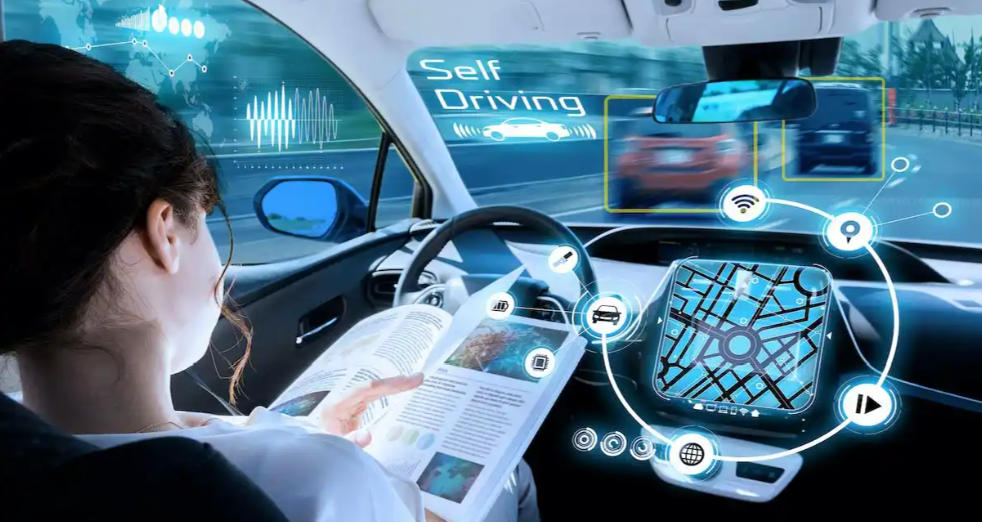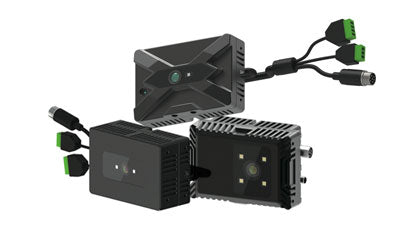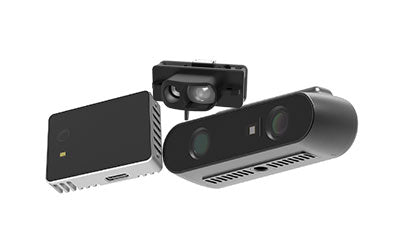ToF Sensors Driving Safety and Precision in Autonomous Vehicles

How exactly do ToF sensors keep drivers and passengers safe in autonomous cars?
As the global automotive industry accelerates toward intelligent and electrified mobility, 3D sensing technology has become a key enabler of automotive safety and advanced driver assistance systems (ADAS). Among various depth-sensing technologies, TOF (Time-of-Flight) sensors—known for their high precision, fast response, and strong ambient light resistance—are driving the next generation of smart vehicle safety.
What Is the Meaning of Autonomous Driving?
Autonomous driving refers to the technology that enables a vehicle to operate without human intervention, using onboard sensors, artificial intelligence (AI), computer systems, and navigation technologies to control steering, acceleration, and braking.
In simple terms, an autonomous vehicle can “drive itself” from the starting point to the destination.
Key features include:
-
Environmental Perception – Using Radar, LiDAR, cameras, and ToF sensors to detect roads, vehicles, pedestrians, and obstacles in real time.
-
Decision-Making and Planning – The AI system interprets perception data to determine driving routes, speed control, and obstacle avoidance strategies.
-
Automatic Control – The vehicle automatically manipulates the steering wheel, throttle, and brakes based on the planned route to ensure safe driving.
-
Smart Connectivity – Integrates with V2X, cloud navigation, and traffic management systems to enhance efficiency and safety.
1. Rapid Growth in Automotive Depth-Sensing Demand
With the fast development of autonomous driving and Driver Monitoring Systems (DMS), the automotive industry is increasingly demanding high-precision spatial perception and real-time environmental detection.
While traditional sensors such as Radar and LiDAR perform well in long-range detection, they still have limitations in close-range accuracy, micro-motion recognition, and in-cabin monitoring.
As a result, more automakers are adopting 3D ToF camera modules, 3D ToF sensors, ToF depth cameras, and 3D depth sensors—collectively known as Time of Flight (ToF) sensors—to achieve millimeter-level distance measurement, millisecond-level response, and all-weather adaptability.
ToF sensors not only enhance pedestrian and obstacle detection outside the vehicle but also enable in-cabin functions like driver posture monitoring, fatigue detection, and gesture control, greatly improving intelligent driving and human–machine interaction.
According to Fortune Business Insights, as ADAS and smart cockpit applications expand, the ToF Sensor Market is expected to grow at a CAGR exceeding 18% over the next five years, making it one of the fastest-growing segments of the 3D Sensor Market.
Major 3D sensing technology companies such as STMicroelectronics (ST ToF Sensor), Infineon (REAL3), and Texas Instruments (TI ToF Sensor) are actively developing automotive-grade ToF modules. As costs fall and integration improves, more vehicles will feature ToF-based exterior environment perception and driver monitoring systems, enabling comprehensive smart driving experiences.
In summary, the automotive industry’s demand for high-precision 3D sensing technology is rapidly increasing. With its precision, speed, and interference resistance, the ToF sensor has become a core solution for both autonomous driving and driver monitoring, driving the global ToF sensor applications and 3D sensing module markets toward high growth.
2. Core Applications of ToF Technology in Vehicles
With the rise of autonomous driving and smart cockpits, Time of Flight (ToF) sensors play an essential role in both vehicle safety and human–machine interaction. Through 3D ToF sensors, ToF 3D cameras, and ToF depth sensors, automakers can achieve precise perception of internal and external environments, providing real-time data for ADAS and intelligent cockpit systems.
1. Environmental Scanning and Obstacle Detection
ToF 3D cameras and ToF ranging sensors generate high-resolution depth maps within milliseconds, enabling real-time scanning of the vehicle’s surroundings. Their main roles include:
-
Pedestrian and Obstacle Detection – Using ToF 3D depth cameras, the system accurately measures distances to pedestrians, vehicles, and obstacles, supporting Automatic Emergency Braking (AEB) and Adaptive Cruise Control (ACC).
-
Low-Light and Harsh Environment Sensing – Integrated with AI vision systems, ToF sensors maintain stable performance in both dark and bright conditions, improving safety.
-
Parking and Low-Speed Assistance – The precise range measurement of ToF ranging sensors enhances automatic parking, reversing, and blind-spot monitoring functions.
Main automotive-grade solutions include:
-
Infineon REAL3 ToF Sensor
-
TI ToF Sensor (Texas Instruments)
-
STMicroelectronics Time of Flight Sensor
These sensors provide accurate ToF sensor distance, ToF sensor range, and ToF sensor resolution measurements while maintaining low power consumption, making them ideal for automotive environments.
2. Driver Monitoring System (DMS)
In-cabin ToF sensor cameras and ToF depth sensors precisely capture facial features, head position, and gaze direction, allowing real-time detection of driver fatigue and distraction.
Advantages include:
-
High Light Adaptability – ToF imaging is independent of ambient light, functioning reliably in both bright and dark environments.
-
Micro-Motion Detection – With ToF image sensors, the system recognizes micro-expressions such as blinking, yawning, or nodding for early safety warnings.
-
AI + ToF Integration – Combined with deep learning, ToF systems can predict driver behavior and prevent potential accidents before they happen.
3. In-Cabin Smart Interaction and Occupant Detection
3D ToF modules are widely used in smart cockpits, enabling gesture control, occupant monitoring, and Child Presence Detection (CPD).
-
Gesture Control – Drivers can adjust volume, air conditioning, or navigation simply through hand gestures, creating a contactless interaction experience.
-
Occupant Monitoring – ToF camera modules detect the number, posture, and position of passengers, improving airbag deployment, climate control, and lighting optimization.
-
Child Safety – ToF sensor modules can identify children left inside vehicles, preventing potential safety hazards.
In conclusion, ToF technology significantly enhances vehicle perception, safety, and interaction. As 3D ToF modules and the ToF sensor market continue to evolve, future vehicles will deliver smarter, safer, and more immersive driving experiences powered by advanced 3D sensing technology.
III. ToF Technical Specifications and Industry Challenges
In the automotive industry, the application of Time of Flight (ToF) Sensors requires not only high-precision distance measurement and fast response but also environmental adaptability and automotive-grade reliability. Below is a detailed analysis of technical specifications and current industry challenges.
1. Technical Specifications
-
Distance Accuracy (ToF Sensor Accuracy): Modern automotive-grade 3D ToF Sensors typically require accuracy within ±1 cm, ensuring precise detection of pedestrians, vehicles, and obstacles for autonomous driving systems.
-
Response Time (ToF Sensor Response Time): Measurement latency of < 5 ms allows systems like Automatic Emergency Braking (AEB), Adaptive Cruise Control (ACC), and obstacle avoidance to react within milliseconds.
-
Ambient Light Immunity (ToF Sensor Ambient Light Immunity): Up to 100k lux, maintaining stable performance under strong sunlight or complex lighting conditions, ensuring reliable monitoring during night driving or in tunnels.
-
Operating Temperature Range (Automotive ToF Operating Range): -40℃ ~ +105℃, suitable for various climates and in-vehicle environments.
-
Modular and Compact Design (3D ToF Module / 3D ToF Camera Module): Compact structure allows integration into dashboards, rearview mirrors, rooftops, or front radar systems, balancing tof sensor distance and tof sensor resolution while maximizing space efficiency.
-
Resolution and Field of View (ToF Sensor Resolution & Field of View): High-resolution ToF Depth Cameras support fine motion detection and small object recognition, such as Child Presence Detection (CPD) and driver micro-expression monitoring.
2. Industry Challenges
Despite the significant advantages of 3D ToF Sensors in autonomous driving and Driver Monitoring Systems (DMS), several challenges remain:
-
Cost Control (ToF Sensor Cost Challenges): Automotive-grade ToF Sensor Modules and high-resolution ToF Sensor Cameras are still expensive to manufacture, especially in mass production, posing cost pressures on automakers.
-
Reliability and Standardization (Reliability & Standardization): Automotive electronics must comply with ISO 26262 functional safety standards, requiring strict hardware, software, and algorithm standards for ToF Sensor Systems to ensure reliable operation in all scenarios.
-
Regulatory Compliance (Regulatory Compliance): The EU, US, and China have strict standards for intelligent driving sensors, covering imaging accuracy, privacy protection, and occupant detection functions. 3D ToF Camera Modules must meet these legal and regulatory requirements.
-
Environmental and Physical Challenges (Environmental & Physical Challenges): Rain, snow, fog, dust, and reflective surfaces can affect the measurement accuracy of ToF 3D Depth Cameras, necessitating algorithm optimization and multi-sensor fusion.
-
System Integration Complexity (Integration Complexity): Integrating ToF 3D Modules with ADAS, DMS, and smart cockpit systems requires precise hardware layout, signal processing, and real-time data communication, increasing design complexity.
Automotive-grade ToF Sensors demand high-precision measurement, low-latency response, wide environmental adaptability, and modular design. Industry challenges focus on cost, reliability, standards, and complex environmental adaptability. With deeper integration of 3D ToF Sensors, ToF Camera Modules, and AI + ADAS, future automotive ToF systems will enable safer, more efficient, and intelligent environmental perception, supporting autonomous driving and driver monitoring.
IV. Market Trends and Competitive Landscape
Currently, the market is dominated by global semiconductor giants such as STMicroelectronics (ST ToF Sensor), Infineon Technologies (Infineon REAL3), Texas Instruments (TI ToF Sensor), and On Semiconductor Sensors.
Meanwhile, domestic Chinese manufacturers are actively developing 3D Semiconductor and ToF 3D Depth Sensing technologies, accelerating independent innovation and local substitution.
-
Market Forecast:
-
By 2030, the Automotive ToF Sensor Market is expected to exceed $3 billion.
-
Automotive 3D Sensing Applications will cover ADAS, DMS, HMI, human-vehicle interaction, occupant monitoring, and other subfields.
-
V. Recommendations for Automotive Component Manufacturers and System Integrators
-
Adopt automotive-grade ToF Sensor Modules and 3D ToF Camera Modules to ensure measurement accuracy and light immunity.
-
Combine AI + ToF + Edge Computing to optimize algorithms for real-time object recognition and behavior prediction.
-
Select suppliers with mature supply chains (e.g., ST, Infineon, TI) to ensure module reliability and mass production capability.
-
Develop a software ecosystem to build in-vehicle vision perception platforms, enhancing intelligent vehicle interaction experiences.
-
Monitor ToF Sensor Market trends and regulatory developments to proactively achieve automotive-grade certification and standard compliance.
VI. Conclusion: ToF Leading a New Era of Automotive Perception
With the deep integration of AI, 5G, and ToF Systems, vehicles are evolving from “passive machines” into “intelligent companions” capable of environmental understanding and proactive decision-making.
Time of Flight Sensors, 3D ToF Camera Modules, and ToF Depth Cameras are reshaping the future of automotive safety—making driving safer, interactions more natural, and travel more efficient.
In the future, ToF Technology will become the 'visual core' of every smart vehicle, leading the global automotive industry toward a smarter, safer, and greener era.
Synexens 3D Camera Of ToF Sensor Soild-State Lidar_CS20
-
Postado em
CS20






